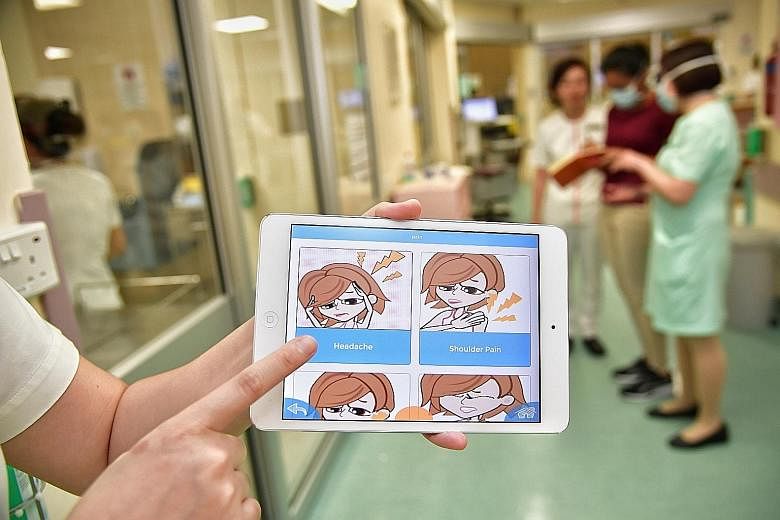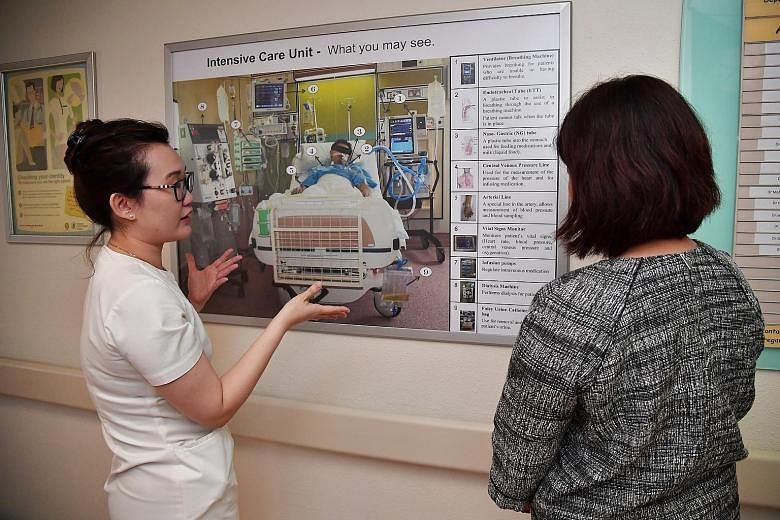Waking up in an intensive care unit (ICU) can be an intimidating and nerve-racking experience.
When 20-year-old Mindy (not her real name) stirred awake in Singapore General Hospital (SGH) in 2014 after a bad traffic accident, a tube had been inserted down her throat and she was hooked up to several machines.
She could not speak and was only able to communicate her feelings by typing out a message on her brother's mobile phone. With a few taps on the screen, she wrote: "I am so scared."
Senior staff nurse Joanne Chong, who witnessed the incident, realised communication between patients and nurses in the ICUs could be improved using mobile technology.
A team from SGH worked on the idea and that same year, the hospital introduced iPads in the ICUs for patients to convey their needs to nurses more easily.
Other hospitals have done something similar.
Ms Chong, 32, recalled how the patient struggled to express her fears. Mindy had tried to yank out the tube that was helping her to breathe and her cardiac monitor beeped faster because she was anxious.
Ms Chong, who was alerted to her patient regaining consciousness, tried to get the young woman to stay calm.
She noticed Mindy was trying to say something, but could not because of the breathing tube.
"There was so much frustration on both sides at this point. I knew the worst thing she could do was to pull that tube out, but I also knew that she desperately wanted to say something to me and she couldn't because of it," said the nurse who has been with SGH since 2009.
Ms Chong handed her patient a paper and pen, but the accident had left the young woman with sore and bruised hands that were unable to hold a pen.
The patient's brother pulled out his mobile phone and told her to type out what she wanted to say. Mindy did so with relative ease.
The hospital's iPads come with third-party apps that have shortcuts for patients to indicate things such as pain, which nurses at SGH say is the most common concern in ICUs.
Changi General Hospital (CGH) also introduced iPads as a communication tool for ICU patients, in 2012.
A patient care communicator app called Touch of Care was developed by the hospital's nurses in partnership with Integrated Health Information Systems, the technology agency for healthcare in Singapore.
Tan Tock Seng Hospital (TTSH) also introduced an app on the mini iPads that its nurses carry around, to ease communication between patients and nurses. They began using the app, written by an overseas hospital, last year.
National University Hospital (NUH) said it does not have designated iPads for people to communicate with nurses, but it does allow patients to use their own devices, like smartphones, to type what they want to say.
The hospitals have also looked at how they can better communicate with the ICU patients' next of kin, and not just with devices.
Many family members do not know what the machines are for and worry about their loved ones helplessly lying on the bed, attached to many beeping devices.
SGH, CGH and NUH have print or digital material which they share with the patient's family members to explain the common machines and their roles.
At SGH, each ICU ward has a different wall poster, about the size of two A3-size sheets, explaining the instruments and medical terms that the family might encounter in the specific ICU ward.
For example, in the surgical ICUs, dialysis machines 1.6m tall are commonplace.
But in the burns ICU, a portable gas and electricity supply called a Hanuport is used to move machines - like physiologic monitors that track patient's vital signs - attached to it more easily.
SGH started the initiative in 2013 for the surgical and medical ICUs, and in 2015 for the burns ICU.
CGH did something similar in 2015. They have a set of orientation slides explaining what some of the machines in the ICU are, what they are used for, as well as information like visiting hours.
This deck of slides are on the nurses' iPads for easy reference and in the form of posters that are displayed within the ICUs.
At NUH, brochures introduced in 2010 serve the same purpose.
All four public hospitals have white boards in ICU wards describing the treatment plan for the day, as well as any special procedures that may take place that day.
For example, if a patient has daily consultations with a doctor, but needs to go for a scan too, then all this information goes on the board so family members are kept informed.
However, the hospitals maintain that there is no substitute for face-to-face communication between doctors, nurses, patients and families.
SGH's assistant director of nursing Patricia Yong said: "Nothing beats us talking to the patients. They need to hear from us what is going on and what we will do for them."


